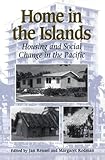Home in the Islands : Housing and Social Change in the Pacific / ed. by Margaret Rodman Critchlow, Jan Rensel.
Material type: TextPublisher: Honolulu : University of Hawaii Press, [1997]Copyright date: ©1997Description: 1 online resource (240 p.)Content type:
TextPublisher: Honolulu : University of Hawaii Press, [1997]Copyright date: ©1997Description: 1 online resource (240 p.)Content type: - 9780824862862
- 363.5099
- HD7387.55.A3.H65 1997eb
- online - DeGruyter
| Item type | Current library | Call number | URL | Status | Notes | Barcode | |
|---|---|---|---|---|---|---|---|
 eBook
eBook
|
Biblioteca "Angelicum" Pont. Univ. S.Tommaso d'Aquino Nuvola online | online - DeGruyter (Browse shelf(Opens below)) | Online access | Not for loan (Accesso limitato) | Accesso per gli utenti autorizzati / Access for authorized users | (dgr)9780824862862 |
Frontmatter -- Contents -- Prologue. Margaret Rodman -- 1. Introduction -- 2. From Thatch to Cement: Social Implications of Housing Change on Rotuma -- 3. Samo House Styles and Social Change -- 4. Changes in Housing and Residence Patterns in Galilo, New Britain, 1918–1992 -- 5. Transformations in the Domestic Landscape of New Zealand Homesteads -- 6. Private Houses, Public Sharing: Pollapese Migrants Coping with Change -- 7. A Samoan Solution to the Limitations of Urban Housing in New Zealand -- 8. From Houses without Walls to Vertical Villages: Samoan Housing Transformations -- 9. (Not) In My Back Yard Housing the Homeless in Hawai‘i -- 10. Conclusion -- References -- Contributors -- Index
restricted access online access with authorization star
http://purl.org/coar/access_right/c_16ec
Ordinary houses have extraordinary stories to tell. For more than a century, anthropologists have been recording these sagas in an attempt to uncover humanity's relationship with the common dwelling. Fundamental to the interaction of humans and housing is the way people shape their living spaces, even redefining their purposes and meanings; their houses, in turn, influence how people live their lives and perpetuate the cultural structures that produced a given form of shelter.The stories draw attention to colonial and missionary agendas, local and global economies, environmental disasters, cultural identities, social connections, and family continuity, as well as personal choices. And, as the chapter on homeless Hawaiians shows, even those without houses have stories to tell. Anthropologists, architects, environmental designers, geographers, and historians will welcome this diverse volume on a neglected yet important aspect of change in the lives of Pacific Islanders.
Mode of access: Internet via World Wide Web.
In English.
Description based on online resource; title from PDF title page (publisher's Web site, viewed 02. Mrz 2022)


